Mogao Caves, also called Thousand-Buddha Caves, are located in Dunhuang, west side of the Hexi Corridor. They were built in Former Qin Dynasty (351 - 394) during the Sixteen Kingdoms Period and renovated in Northern Dynasty Period (386 - 581), Sui (581 - 619), Tang (618 - 907), Five Dynasties Period (304 - 439), Western Xia (1038 -1227), and Yuan (1271 - 1368) eras. There are altogether 735 caves, 2,415 colored clay sculptures, and 45,000 square meters of murals in the caves, making it a scared place for Buddhism and the largest and the richest Buddhist treasure house. The whole sight is divided into northern and southern areas, in which the southern caves are the major sections that houses the murals and sculptures, while the northern caves are more about the places where monks live, perform their daily Buddhist duties and were buried in. There are fire pits, heatable bed made out of mud, chimneys, lamps and niches.
When was the Mogao Grottoes built and who built it?
During 139 .c- 119.c, Zhang Qian made two envoys to western regions, breaking the cultural and economic ice between China and western regions. While Dunhuang, as a strategical traffic hub city along the Silk Road, served as a place both accepting and exporting goods and ideas. The excavation of Mogao Caves started in 366. According to related chronicles, a Buddhist master named Le Zun had an epiphany when he passed by Dunhuang. Therefore, he chiseled the first cave here. Later, another Zen master named Fa Liang came here and changed its name as Mogao Caves.
During Northern Dynasties, the rulers revered at the Buddhism, which enabled the further expansion of the Mogao Caves. In Sui and Tang Dynasties, the prosperity of Silk Road also prompted the flourishing of Mogao Caves. There were more than 1,000 caves excavated during the reign of Wu Zetian age. However, with the decline of Tang Dynasty, the popularity of Buddhism began to recede. After Yuan Dynasty, the caves were neglected until the Qing Dynasty when Emperor Qianlong renamed Shazhou to Dunhuang county. People began to realize the importance of the caves.
What are the Mogao Caves in China are known for?
Unique Architecture
There are over 500 caves in Mogao Caves, among which 492 caves house countless pieces of paintings and painted sculptures. 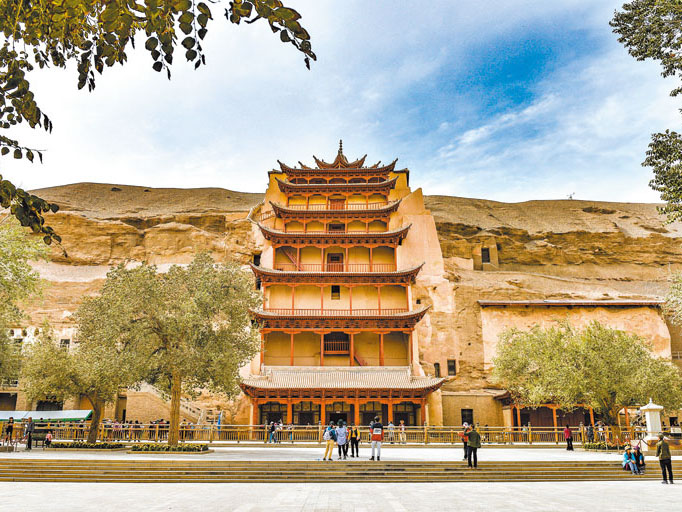 Based on the cave architecture and function, these caves were classified into Central Pillar Caves, Hall Caves, Grottoes with Inverted Funnel-shaped Roof, Caves of Giant Buddha Statue, Chan Caves, Monk Houses, etc.. The largest grotto can be 40m in height and 30m in width. While the smallest cave can be as little as less than a foot. The Central Tower Types of caves retained in early times show that the ancient artists not only absorbed the foreign art forms, but also localized these architecture to accommodate the aesthetic appreciation of Chinese people. Outside many caves are the wooden cave eaves from Tang and Song Dynasties, which make valuable physical material of ancient wooden structures.
Based on the cave architecture and function, these caves were classified into Central Pillar Caves, Hall Caves, Grottoes with Inverted Funnel-shaped Roof, Caves of Giant Buddha Statue, Chan Caves, Monk Houses, etc.. The largest grotto can be 40m in height and 30m in width. While the smallest cave can be as little as less than a foot. The Central Tower Types of caves retained in early times show that the ancient artists not only absorbed the foreign art forms, but also localized these architecture to accommodate the aesthetic appreciation of Chinese people. Outside many caves are the wooden cave eaves from Tang and Song Dynasties, which make valuable physical material of ancient wooden structures.
Painted Sculptures
Excavated on the conglomerate rocks, most caves were wooden structures 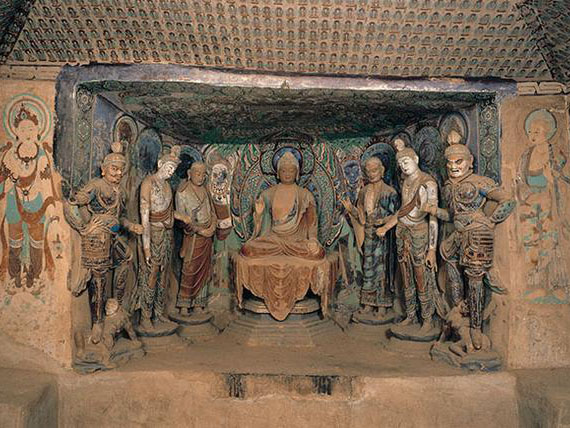 except the Northern and Southern Statues that were built against the mountains. Painted sculpture is the major art form in Mogao Caves. Many subjects were made in such a form, including the Buddha statues, disciples' statues, heavenly Kings, vajras, and gods. There are also diversified forms of painted sculptures, such as free-standing statues, relief statues, clay-molding sculptures, and more. Meanwhile, the rich themes and the sophisticated sculpturing skills are just marvelous, making the caves the museum for Buddhist painted sculptures.
except the Northern and Southern Statues that were built against the mountains. Painted sculpture is the major art form in Mogao Caves. Many subjects were made in such a form, including the Buddha statues, disciples' statues, heavenly Kings, vajras, and gods. There are also diversified forms of painted sculptures, such as free-standing statues, relief statues, clay-molding sculptures, and more. Meanwhile, the rich themes and the sophisticated sculpturing skills are just marvelous, making the caves the museum for Buddhist painted sculptures.
Murals
The cave murals are just rich and magnificent. All kinds of scenes 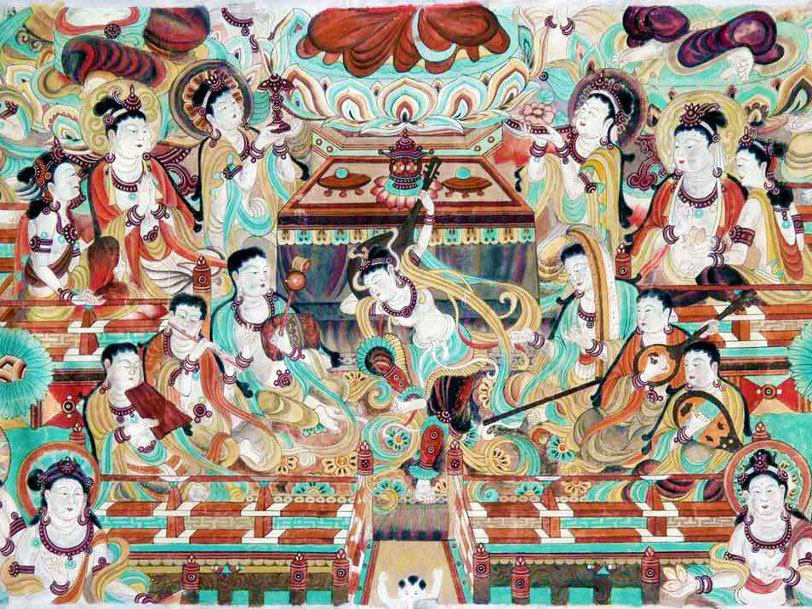 were displayed on those murals, covering from the Buddhist stories, landscapes like mountains, rivers and flowers, buildings of pavilions and attics, to flying Buddhas and various ordinary social lives, presenting the folk culture and historical changes of the society from Sixteen States Period to Qing Dynasty and making the caves precious materials to study the art and history of China. Besides, these mural arts also absorbed the art forms of ancient Iran, India and Greece, making it clear that ancient China had a long history with western world.
were displayed on those murals, covering from the Buddhist stories, landscapes like mountains, rivers and flowers, buildings of pavilions and attics, to flying Buddhas and various ordinary social lives, presenting the folk culture and historical changes of the society from Sixteen States Period to Qing Dynasty and making the caves precious materials to study the art and history of China. Besides, these mural arts also absorbed the art forms of ancient Iran, India and Greece, making it clear that ancient China had a long history with western world.
Highlights of Mogao Caves
Cave 96
Chiseled in early Tang Dynasty (618-705), the Cave 96 has the largest Buddha Statue with 35.5m in height and 12m in width. According to the Mogao Grottoes Inscriptions, the statue was built by Buddhist Lingyin and Yinzu in 695 and it was the Future Buddha Maitreya, the successor of Sakyamuni. The statue was made by the carving a rough shape the Buddha on the stone and then molding and painting the body with mud made from grass and loam. Although the original colors faded with time, we can still have a glimpse of the how magnificent it must be back then. In front the Cave 96 stands the Nine-story Building with disorderly eaves, which is one of the symbols of Mogao Caves.
The Library Cave
The Liberary Cave, located in Cave 17 was excavated in late Tang Dynasty. In the early 11th century, to elude from the Western Xia troops, the monks in Mogao Caves buried over 50,000 pieces of Buddhist scriptures, paintings, embroideries, silk paintings, dharma-vessels, and other religious and social documents in this cave with its door sealed and decorated with murals. 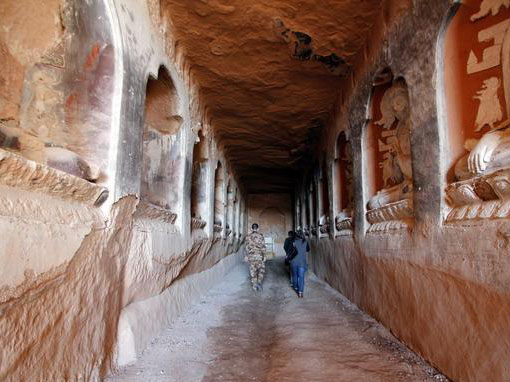 Many people forgot about the treasures hidden here.
In 1900, a Taoist master named Wang Yuanlu made an accidental discovery of the cave while cleaning up the accumulated sand. Unfortunately, many foreign groups learned the news, they made fraudulent purchases from Wang Yuanlu and seized nearly 40,000 pieces of treasures.
The finding of Liberary Cave was a breakthrough in Chinese archaeology as there were many documents in Chinese, ancient Tibetan Language, Sanskrit, Qilu, Huihu, Hebrew, Guizi languages. The contents of these documents were mostly Buddhist scriptures, some were Taoism classics, Confucianism classics, novels, poets, chronicles, manuscripts, pledges and more. Studying these materials will enable us to have a better understanding of the history of China and Central areas. Therefore, a new academic discipline named Dunhuangology was formed.
Many people forgot about the treasures hidden here.
In 1900, a Taoist master named Wang Yuanlu made an accidental discovery of the cave while cleaning up the accumulated sand. Unfortunately, many foreign groups learned the news, they made fraudulent purchases from Wang Yuanlu and seized nearly 40,000 pieces of treasures.
The finding of Liberary Cave was a breakthrough in Chinese archaeology as there were many documents in Chinese, ancient Tibetan Language, Sanskrit, Qilu, Huihu, Hebrew, Guizi languages. The contents of these documents were mostly Buddhist scriptures, some were Taoism classics, Confucianism classics, novels, poets, chronicles, manuscripts, pledges and more. Studying these materials will enable us to have a better understanding of the history of China and Central areas. Therefore, a new academic discipline named Dunhuangology was formed.
Travel Guide:
Entrance ticket: 238RMB/pax (Mogao Caves: 180RMB; Digital Display Center: 48 RMB; Shuttle bus: 10 RMB).
Opening Hours:
Peak Seasons (April 1 - November 30): 8:30 - 18:00; Digital Display Center: 7:30 - 15:30;
Low Seasons (December 1 - March 31): 09:00 - 17:30; Digital Display Center: 08:30 - 15:00.
Transportation:
Location: nearby the No.314 provincial highway, Dunhuang, Gansu
How to get there: It takes about 10km from downtown Dunhuang by car. If you want to take bus, please go to the bus station right cross the Yiyuan Hotel and take the Bus 12.
Distance from other sights: 42.1km from West Thousand Buddha Caves; 11.6km from Singing Sand Dunes and Crescent Spring; 25.5km from the Dunhuang Ancient Town; 69.8km from Yangguan Pass; 102.3km from Yumen Pass; 172km from Yardan Geological Park and 153.4km from Yulin Caves.
Related Tours
8 Days In-depth Silk Road Culture Tour to Dunhuang and Zhangye
11 days China Silk Road Trip
15-day Silk Road and Xinjiang Tour
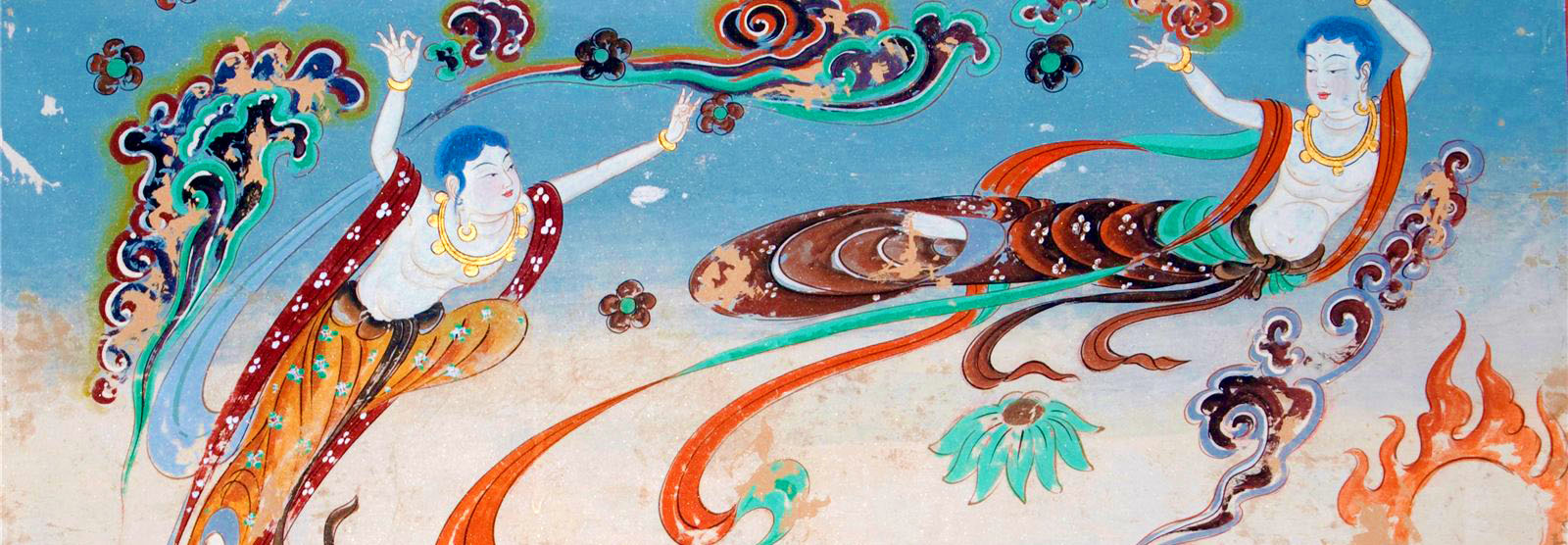
 Based on the cave architecture and function, these caves were classified into Central Pillar Caves, Hall Caves, Grottoes with Inverted Funnel-shaped Roof, Caves of Giant Buddha Statue, Chan Caves, Monk Houses, etc.. The largest grotto can be 40m in height and 30m in width. While the smallest cave can be as little as less than a foot. The Central Tower Types of caves retained in early times show that the ancient artists not only absorbed the foreign art forms, but also localized these architecture to accommodate the aesthetic appreciation of Chinese people. Outside many caves are the wooden cave eaves from Tang and Song Dynasties, which make valuable physical material of ancient wooden structures.
Based on the cave architecture and function, these caves were classified into Central Pillar Caves, Hall Caves, Grottoes with Inverted Funnel-shaped Roof, Caves of Giant Buddha Statue, Chan Caves, Monk Houses, etc.. The largest grotto can be 40m in height and 30m in width. While the smallest cave can be as little as less than a foot. The Central Tower Types of caves retained in early times show that the ancient artists not only absorbed the foreign art forms, but also localized these architecture to accommodate the aesthetic appreciation of Chinese people. Outside many caves are the wooden cave eaves from Tang and Song Dynasties, which make valuable physical material of ancient wooden structures.
 except the Northern and Southern Statues that were built against the mountains. Painted sculpture is the major art form in Mogao Caves. Many subjects were made in such a form, including the Buddha statues, disciples' statues, heavenly Kings, vajras, and gods. There are also diversified forms of painted sculptures, such as free-standing statues, relief statues, clay-molding sculptures, and more. Meanwhile, the rich themes and the sophisticated sculpturing skills are just marvelous, making the caves the museum for Buddhist painted sculptures.
except the Northern and Southern Statues that were built against the mountains. Painted sculpture is the major art form in Mogao Caves. Many subjects were made in such a form, including the Buddha statues, disciples' statues, heavenly Kings, vajras, and gods. There are also diversified forms of painted sculptures, such as free-standing statues, relief statues, clay-molding sculptures, and more. Meanwhile, the rich themes and the sophisticated sculpturing skills are just marvelous, making the caves the museum for Buddhist painted sculptures.
 were displayed on those murals, covering from the Buddhist stories, landscapes like mountains, rivers and flowers, buildings of pavilions and attics, to flying Buddhas and various ordinary social lives, presenting the folk culture and historical changes of the society from Sixteen States Period to Qing Dynasty and making the caves precious materials to study the art and history of China. Besides, these mural arts also absorbed the art forms of ancient Iran, India and Greece, making it clear that ancient China had a long history with western world.
were displayed on those murals, covering from the Buddhist stories, landscapes like mountains, rivers and flowers, buildings of pavilions and attics, to flying Buddhas and various ordinary social lives, presenting the folk culture and historical changes of the society from Sixteen States Period to Qing Dynasty and making the caves precious materials to study the art and history of China. Besides, these mural arts also absorbed the art forms of ancient Iran, India and Greece, making it clear that ancient China had a long history with western world.  Many people forgot about the treasures hidden here.
Many people forgot about the treasures hidden here.